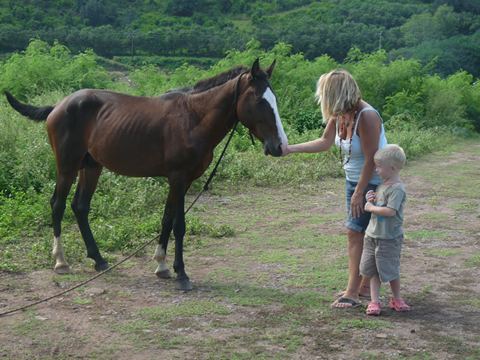The Tuamotu Archipelago

Catacaos
Graham Shaw
Tue 28 Jun 2011 21:43
|
Most people have probably never heard of the
Tuamotu Archipelago, yet here is a group of 78 islands streching over a thousand
miles across the middle of French Polynesia. Sadly the most well known of
the islands is the atoll of Mururoa at the far eastern end of the archipelago,
famous for having been one of the main areas for nuclear weapons testing.
Fortunately this ended at the beginning of 1996, although the area around
Mururoa is still off limits to visitors. Our route through the Tuamotu has
taken us via the atolls of Manihi, Ahe and Rangiroa, at the far western end of
the group. These were all quite different to each other, with Manihi being
our first stop after leaving from the island of Nuku Hiva in the Marquesas
Islands three days previously.
The Marquesas have many horses: one island - Ua
Huka - having something like 1500 living wild, yet only about 300 people.
In Nuku Hiva, where this picture was taken, horses still seemed to being used as
daily transport (though most folk have a 4x4), and there were many to be seen
around.
 The day before we left there was prirogue
(Polynesian outrigger canoe) racing. The mens event was a 22km sprint in
open water which was pretty choppy. Here in the bay where we were anchored
it was very calm, close to the finish line.
 In complete contrast to the mountainous Marquesas
(Nuku Hiva has the third highest waterfall in the world, just give some idea),
the Tuamotu are almost all coral atolls, most of them rising to barely three
metres above sea level. The atolls are coral reefs surrounding a lagoon
where there had one been the peak of a volcano. Most of these reefs have
gaps in them, known as passes, through which boats can navigate, and then once
inside the lagoon, the water is generally calm with some incredible shades
of blue. Below is Catacaos anchored in Manihi, our first
stop. The island (or motu as they are correctly called) in the background was only about fifty metres
wide in places, and on the ocean side there was a beach somewhat protected by
the reef, where Lorraine and Lucas spent many hours looking for shells, and now
have quite a collection.
  The atolls are also known for the production of
black pearls, which are farmed on quite a large commercail scale. In
Rangiroa we visited one of the pearl farms, but more of that later.
 We happened to be in Manihi when the supply ship
came in. In many of the islands this happens only every few
weeks (note this everyone writing to the Guernsey Press about a ferry company),
so is a big occasion, and everyone turns out to find their stuff which has
hopefully arrived. A fleet of forklifts scurried about dropping containers
and loose cargo outside shops and people's houses. Various vehicles, a
boat and a goat were discharged from the ship, and it was then on its way again,
to the next island.
 I was glad to see that tracked excavators cause the
same amount of grief to ship operators the world over:
 The goat came off next:
 And then everything else:
 Next stop was the neighbouring atoll of Ahe, where
there are only about two hundred inhabitants. More vivid blue colours, and
more shells to be collected from the beach.
  The French taxpayer will be pleased to hear that he
has provided the good people of Ahe with many solar panels to provide them with
electricity. Apparently, in very enterprising fashion, some of these have
been sold to passing yachtsmen.
 The supply ship coming in to Ahe:
 Note the tricky navigation for a vessel of this
size - very shallow water in the foreground of this picture:
 The entrance to the pass at Rangiroa. Timing
is critical for running the passes, as in some atolls the current can be flowing
one way or the other at up to nine knots!
 Once inside the lagoon, all is calm and still
again:
 At the pearl farm in Rangiroa:
 In this picture above, the nucleus is being
inserted into the oyster. The whole farming process is quite intensive and
artificial - the nucleii are imported from Mississippi, bizarrely, and the
oysters are kept in very controlled conditions until the pearls mature after
several years. The black pearls for which this place is famous are so
called not because of their colour, but that they are grown in the black-lipped
oyster, which is indigenous to the Tuamotu Islands. Quality varies
considerably, and prices range from not a lot, to ridiculous. Or so it
seemed to us!
 Above, typical garden scene in
Rangiroa.
 On the inside of the lagoon at Rangiroa. This
is the largest atoll in French Polynesia, and has a population of nearly 2500
people. The facilities here are therefore a bit more developed than
elsewhere in the island chain, having a couple of stores which almost pass for
supermarkets. The scuba diving here is rated very highly, and Lorraine is
probably going to give that a go later on today. We'll most likely be here
for another few days, before heading off for the two hundred mile trip down to
Papeete in Tahiti. This is the largest city in all the Pacific islands and
we will be there a while to sort out a few things on the boat before continuing
on ever westwards.
|